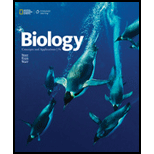
Concept explainers
Which is not a
| a. adenine | c. glutamine | e. cytosine |
| b. guanine | d. thymine | f. All are in DNA. |
Introduction:
DNA is a polymer of nucleotides. Each nucleotide consists of a deoxyribose sugar, three phosphate groups, and a nitrogen-containing base.
Answer to Problem 1SQ
Correct answer:
Glutamine is not a nucleotide base in DNA. Hence, the correct answer is option c.
Explanation of Solution
Reason for correct answer:
Option c. is given as “glutamine.”
The four nitrogen bases of DNA are adenine, thymine, cytosine, and guanine. Glutamine is one of the
Reason for incorrect answer:
Option a. is given as, “adenine.”
Adenine is one of the two purine bases that form the nucleotides of DNA. Glutamine is classified under the category of amino acids. Hence, option a. is incorrect.
Option b. is given as, “guanine.”
Guanine is a nitrogenous base that belongs to the purine group. Glutamine is absent in the double-stranded DNA structure. Hence, option b. is incorrect.
Option d. is given as, “thymine.”
Thymine belongs to the pyrimidine group of nitrogen bases of DNA. Glutamine does not belong to the category of pyrimidines. Hence, option d. is incorrect.
Option e. is given as, “cytosine.”
Cytosine is a pyrimidine base in the nucleotides of DNA. Glutamine does not belong to the category of either purines or pyrimidines. Hence, option e. is incorrect.
Option f. is given as, “All are in DNA.”
Adenine, thymine, cytosine, and guanine are the four nitrogenous bases present in the double-helical structure of DNA. However, glutamine does not belong to the category of nitrogenous bases present in the DNA molecule. Hence, option f. is incorrect.
Hence, the options a., b., d., e., and f. are incorrect.
The four nitrogen bases of DNA are adenine, thymine, cytosine, and guanine. Glutamine is an amino acid and is absent in DNA bases. Thus, the correct answer is option c.
Want to see more full solutions like this?
Chapter 8 Solutions
Biology: Concepts and Applications (MindTap Course List)
- ✓ Details Draw a protein that is embedded in a membrane (a transmembrane protein), label the lipid bilayer and the protein. Identify the areas of the lipid bilayer that are hydrophobic and hydrophilic. Draw a membrane with two transporters: a proton pump transporter that uses ATP to generate a proton gradient, and a second transporter that moves glucose by secondary active transport (cartoon-like is ok). It will be important to show protons moving in the correct direction, and that the transporter that is powered by secondary active transport is logically related to the proton pump.arrow_forwarddrawing chemical structure of ATP. please draw in and label whats asked. Thank you.arrow_forwardOutline the negative feedback loop that allows us to maintain a healthy water concentration in our blood. You may use diagram if you wisharrow_forward
- Give examples of fat soluble and non-fat soluble hormonesarrow_forwardJust click view full document and register so you can see the whole document. how do i access this. following from the previous question; https://www.bartleby.com/questions-and-answers/hi-hi-with-this-unit-assessment-psy4406-tp4-report-assessment-material-case-stydu-ms-alecia-moore.-o/5e09906a-5101-4297-a8f7-49449b0bb5a7. on Google this image comes up and i have signed/ payed for the service and unable to access the full document. are you able to copy and past to this response. please see the screenshot from google page. unfortunality its not allowing me attch the image can you please show me the mathmetic calculation/ workout for the reult sectionarrow_forwardIn tabular form, differentiate between reversible and irreversible cell injury.arrow_forward
- 1.)What cross will result in half homozygous dominant offspring and half heterozygous offspring? 2.) What cross will result in all heterozygous offspring?arrow_forward1.Steroids like testosterone and estrogen are nonpolar and large (~18 carbons). Steroids diffuse through membranes without transporters. Compare and contrast the remaining substances and circle the three substances that can diffuse through a membrane the fastest, without a transporter. Put a square around the other substance that can also diffuse through a membrane (1000x slower but also without a transporter). Molecule Steroid H+ CO₂ Glucose (C6H12O6) H₂O Na+ N₂ Size (Small/Big) Big Nonpolar/Polar/ Nonpolar lonizedarrow_forwardwhat are the answer from the bookarrow_forward

 Concepts of BiologyBiologyISBN:9781938168116Author:Samantha Fowler, Rebecca Roush, James WisePublisher:OpenStax College
Concepts of BiologyBiologyISBN:9781938168116Author:Samantha Fowler, Rebecca Roush, James WisePublisher:OpenStax College Human Biology (MindTap Course List)BiologyISBN:9781305112100Author:Cecie Starr, Beverly McMillanPublisher:Cengage Learning
Human Biology (MindTap Course List)BiologyISBN:9781305112100Author:Cecie Starr, Beverly McMillanPublisher:Cengage Learning Biology (MindTap Course List)BiologyISBN:9781337392938Author:Eldra Solomon, Charles Martin, Diana W. Martin, Linda R. BergPublisher:Cengage LearningEssentials of Pharmacology for Health ProfessionsNursingISBN:9781305441620Author:WOODROWPublisher:Cengage
Biology (MindTap Course List)BiologyISBN:9781337392938Author:Eldra Solomon, Charles Martin, Diana W. Martin, Linda R. BergPublisher:Cengage LearningEssentials of Pharmacology for Health ProfessionsNursingISBN:9781305441620Author:WOODROWPublisher:Cengage Biology Today and Tomorrow without Physiology (Mi...BiologyISBN:9781305117396Author:Cecie Starr, Christine Evers, Lisa StarrPublisher:Cengage Learning
Biology Today and Tomorrow without Physiology (Mi...BiologyISBN:9781305117396Author:Cecie Starr, Christine Evers, Lisa StarrPublisher:Cengage Learning





